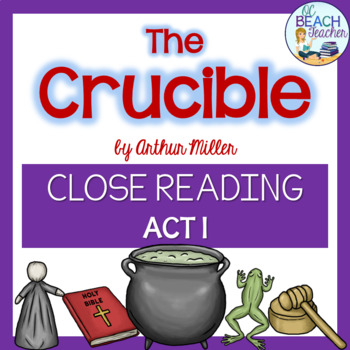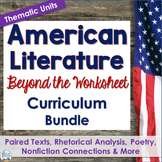Crucible by Arthur Miller - Act 1 Close Reading Lesson and Activity
- PDF
- Easel Activity
Also included in
- Are you new to American Literature or tired of boring worksheets? Engage students with texts by American authors in lessons that use real-world learning connections, an appreciation for cultural diversity, and critical thinking skills. These activities for your American Literature Curriculum are orPrice $104.99Original Price $206.71Save $101.72
- IsThe Crucible your crucible? These activities with excerpts from each act of the play by Arthur Miller will make teaching it easy and meaningful. Use these lessons to teach close reading and to improve reading comprehension. In pre-reading activities, students respond to journal prompts that makePrice $10.80Original Price $15.00Save $4.20
Description
Use these compelling lines in Act 1 of The Crucible by Arthur Miller to teach close reading and to improve reading comprehension. In pre-reading activities, students respond to a journal prompt that makes personal connections and then define vocabulary. Next, they review the think aloud with model annotations and reflect on reading strategies. Post-reading questions include interpreting, analyzing, and evaluating the reading. Furthermore, students complete narrative writing and a short research activity.
This scaffolded approach to reading and analysis is excellent for test preparation, and it meets standards for the Common Core. Student learning targets include the following:
- to read closely and annotate a text.
- to cite textual evidence to support analysis of a text.
- to analyze characters.
- to research a topic related to their reading.
- to participate in meaningful discussion of a text.
- to connect ideas between the text and students’ lives.
This 17-page lesson includes the following:
-explicit lesson plan with identified Common Core ELA Anchor Standards
-pre-reading writing prompt
-vocabulary activity
-think aloud with model annotations
-post-reading questions
-text of Act 1 lines 128 - 163 from The Crucible by Arthur Miller
-key (includes detailed responses for all activities)
In addition to the printable lesson, this resource may be used for online learning with EASEL by TpT.
Interested in similar lessons for the other acts of The Crucible? Click below:
If interested, here are other some other lessons featuring close reading:
Digital Paired Text - The Road Not Taken & Harlem
Digital Paired Text - Ain't I a Woman? and Phenomenal Woman
Paired Text - First Lesson & Those Winter Sundays
Paired Text- Kate Chopin & William Faulkner
Paired Text - Gift of the Magi & How Do I Love Thee?
Meaningful and Memorable English Language Arts by © OCBeachTeacher ™
All rights reserved by author.
Limited to use by purchaser only.
Group licenses available.
Not for public display.








